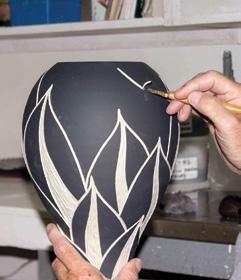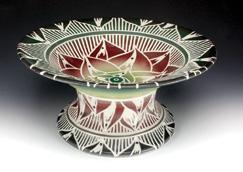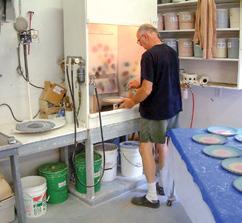
4 minute read
American sgraffito
Bates molded career with ancient technique
Story By JOHN CLAYTON
The potter’s wheel has always been a solitary pursuit for Wayne Bates. Even back in college when he first took up the art form that would shape his adult life, he was “left to his own devices” in the little-used ceramics room at Union University in Jackson, Tennessee.
“They turned me loose in the ceramics studio there,” says Bates. “There was some ceramic materials and a potter’s wheel, and I asked the department if I could use it. They said, ‘Yeah, go ahead.’ So, I had a free ride, and that’s what got me started. They just said to be careful to not burn the building down.”
So, Bates fired the kiln and taught himself the delicate touch of the potter’s wheel. The result was a lifelong passion. “It was a small room in a big building, and it got me interested intellectually,” Bates says.
He has never lost that interest, beginning a career as a teacher and artist after college at Union and graduate school at the University of Georgia where he finished in 1968. He taught ceramics at the Philadelphia College of Art for most of the 1970s before moving to Murray, Kentucky, for a slower pace.
‘SGRAFITTO’
The trains that ran from Philadelphia to New York in the early 1970s opened a world of art galleries and museums for Bates. An exhibition of prehistoric pottery from the Mimbres tribe, a people native to the Arizona and New Mexico desert prior to 1150 A.D., led him to sgrafitto, a type of decoration in ceramics or stucco made by cutting away a layer to reveal another color underneath.

Mimbres pottery featured geometric designs cut into the bowls and other vessels made by members of the tribe. “I didn’t have a deep background in ceramic arts of the day, so that’s why I went to a museum in Manhattan,” Bates says. “The Mimbres used a very geometric design that I got interested in. I was inspired by the Mimbres, really, and started working with geometric designs. Nobody was really doing that at the time, and nobody was really working with color in oil, and I was working with color.”
While Bates was balancing teaching with working on his own creations in
Philadelphia, he didn’t think of himself as a trailblazer as he stepped outside the norms of pottery and ceramics in the 1970s. “I didn’t even know what the norm was,” he recalls. “I was going to do what I thought was interesting. That’s the way I worked out the designs I work with. If they don’t interest me, I’m just not going to do it.”
IN STUDIO
Bates used some of his other skills to build a family home and Blood River Pottery studio in Murray, Kentucky after his wife, Kay, a classically trained vocalist, took a teaching post at Murray State University. As her teaching career started, his ended and he pursued his art full time.
“I learned a lot about the market, and I learned a lot about collectors,” Bates says of his time in Philadelphia. “I had some shows and built a little bit of a reputation, so I came here and went to the big shows. That really helped me get going here.”
For the better part of the next 25 years, following the move to Murray, Bates was on the road or in the studio, moving from show to show while working on his own gallery shows and commissions. The studio was plenty large to accommodate the amount of work Bates created. “It used to be full, but now there’s probably more room than I need,” he says.
While Bates has cut back to part time in the studio, he has branched out to build and oversee his own retail sales website, waynebates.com, as well other art-related websites around the region. “When I quit going on the road, I promoted my website and did a lot through it, even wholesale orders,” he says. “Working on the websites is a nice combination of being able to work with a client and take a break from that and work on the computer. I’ve liked computers right from the very beginning, and I try to keep up with everything that’s current.” What is sgraffito? “The word sgraffito is derived from the Italian word graffito, a drawing or inscription made on a wall or other surface (graffito also gave us the word graffiti). Graffito is past participle of sgraffire, which means “to scratch.” So the word sgraffito basically means to scratch and create a graphic or an image. In ceramics, sgraffito is a technique of ornamentation in which a surface layer is incised to reveal a ground of contrasting color.” – source, Wayne Bates, ceramicartsnetwork.org.

Wayne Bates headlines, commissions and shows
-The Al Smith Fellowship from the Kentucky Department of Arts
-Commissions from the Kentucky Arts Council and the Kentucky State Chamber of Commerce
Shows:
The Best of Kentucky, Museum of Art and Craft, Louisville
From the Earth, University of Kentucky Museum of Art
The Regionalists, Owensboro Museum of Fine Art
On the Surface: An Exhibition of Painterly Clay, Ohio Crafts Museum, Columbus, Ohio
One Man Show, The Clay Pot, Brooklyn, New York
Bourbon Ball, Kentucky Art & Craft Foundation, Louisville
Crafts Alliance Invitational, St. Louis, Missouri
Tea for 200, Incorporated Gallery, New York City
Liberties with Liberty, Craft and Folk Art Museum, Los Angeles
Flower Works and Handbuilt, Kentucky
Clay Artisan Center, Berea Color in Clay, Houston, Texas
SECCA Crafts Invitational, Winston-Salem, North Carolina
Production Lines, Philadelphia College of Art, Philadelphia, Pennsylvania




